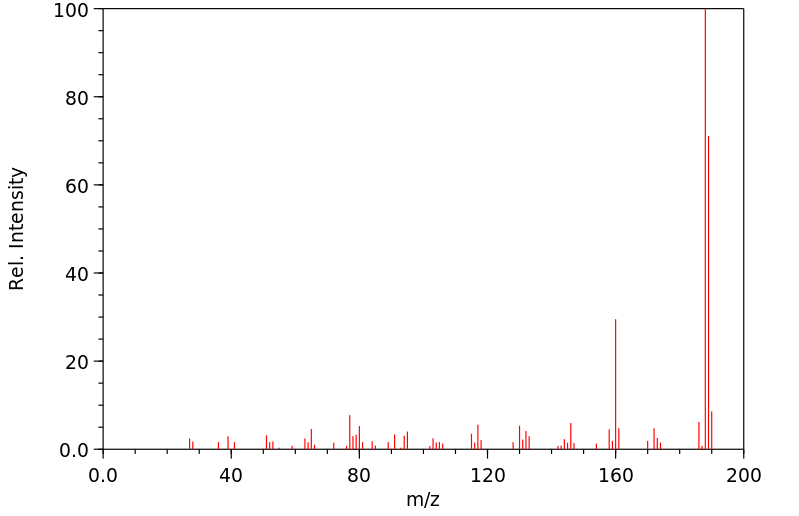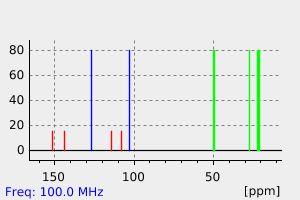8-羟基久洛里定 | 41175-50-2
中文名称
8-羟基久洛里定
中文别名
8-羟基久洛尼定
英文名称
8-hydroxyjulolidine
英文别名
2,3,6,7-tetrahydro-1H,5H-pyrido[3,2,1-ij]quinolin-8-ol;1,2,3,5,6,7-hexahydropyrido[3,2,1-ij]quinolin-8-ol;8-hydroxy-2,3,6,7-tetrahydro-1H,5H-benzo[ij]quinolizine;1H,5H-Benzo[ij]quinolizin-8-ol, 2,3,6,7-tetrahydro-;1-azatricyclo[7.3.1.05,13]trideca-5,7,9(13)-trien-6-ol
CAS
41175-50-2
化学式
C12H15NO
mdl
MFCD00006918
分子量
189.257
InChiKey
FOFUWJNBAQJABO-UHFFFAOYSA-N
BEILSTEIN
——
EINECS
——
-
物化性质
-
计算性质
-
ADMET
-
安全信息
-
SDS
-
制备方法与用途
-
上下游信息
-
文献信息
-
表征谱图
-
同类化合物
-
相关功能分类
-
相关结构分类
物化性质
-
熔点:132-134 °C(lit.)
-
沸点:374.4±41.0 °C(Predicted)
-
密度:1.22±0.1 g/cm3(Predicted)
-
溶解度:可溶于氯仿(少许)、甲醇(少许)
-
稳定性/保质期:
常规情况下不会分解,没有危险反应。
计算性质
-
辛醇/水分配系数(LogP):2.5
-
重原子数:14
-
可旋转键数:0
-
环数:3.0
-
sp3杂化的碳原子比例:0.5
-
拓扑面积:23.5
-
氢给体数:1
-
氢受体数:2
安全信息
-
TSCA:Yes
-
危险品标志:Xi
-
安全说明:S22,S24/25,S26,S37/39
-
危险类别码:R36/37/38
-
WGK Germany:3
-
海关编码:2933990090
-
危险品运输编号:NONH for all modes of transport
-
危险性防范说明:P261,P305+P351+P338
-
危险性描述:H315,H319,H335
-
储存条件:密封、阴凉、干燥保存。
SDS
| Name: | 8-Hydroxyjulolidine 98% Material Safety Data Sheet |
| Synonym: | None |
| CAS: | 41175-50-2 |
Synonym:None
Section 2 - COMPOSITION, INFORMATION ON INGREDIENTS
| CAS# | Chemical Name | content | EINECS# |
| 41175-50-2 | 8-Hydroxyjulolidine | 98 | 255-247-9 |
Risk Phrases: None Listed.
Section 3 - HAZARDS IDENTIFICATION
EMERGENCY OVERVIEW
The toxicological properties of this material have not been fully investigated.
Potential Health Effects
Eye:
May cause eye irritation.
Skin:
May cause skin irritation.
Ingestion:
May cause irritation of the digestive tract. The toxicological properties of this substance have not been fully investigated.
Inhalation:
May cause respiratory tract irritation. The toxicological properties of this substance have not been fully investigated.
Chronic:
No information found.
Section 4 - FIRST AID MEASURES
Eyes: Flush eyes with plenty of water for at least 15 minutes, occasionally lifting the upper and lower eyelids. Get medical aid.
Skin:
Get medical aid. Flush skin with plenty of water for at least 15 minutes while removing contaminated clothing and shoes. Wash clothing before reuse.
Ingestion:
Never give anything by mouth to an unconscious person. Get medical aid. Do NOT induce vomiting. If conscious and alert, rinse mouth and drink 2-4 cupfuls of milk or water.
Inhalation:
Remove from exposure and move to fresh air immediately. If not breathing, give artificial respiration. If breathing is difficult, give oxygen. Get medical aid.
Notes to Physician:
Section 5 - FIRE FIGHTING MEASURES
General Information:
As in any fire, wear a self-contained breathing apparatus in pressure-demand, MSHA/NIOSH (approved or equivalent), and full protective gear. During a fire, irritating and highly toxic gases may be generated by thermal decomposition or combustion.
Extinguishing Media:
Use agent most appropriate to extinguish fire. Use water spray, dry chemical, carbon dioxide, or appropriate foam.
Section 6 - ACCIDENTAL RELEASE MEASURES
General Information: Use proper personal protective equipment as indicated in Section 8.
Spills/Leaks:
Vacuum or sweep up material and place into a suitable disposal container. Clean up spills immediately, observing precautions in the Protective Equipment section. Avoid generating dusty conditions.
Provide ventilation.
Section 7 - HANDLING and STORAGE
Handling:
Wash thoroughly after handling. Remove contaminated clothing and wash before reuse. Use with adequate ventilation. Minimize dust generation and accumulation. Avoid contact with eyes, skin, and clothing. Keep container tightly closed. Avoid ingestion and inhalation.
Storage:
Store in a tightly closed container. Store in a cool, dry, well-ventilated area away from incompatible substances.
Section 8 - EXPOSURE CONTROLS, PERSONAL PROTECTION
Engineering Controls:
Facilities storing or utilizing this material should be equipped with an eyewash facility and a safety shower. Use adequate ventilation to keep airborne concentrations low.
Exposure Limits CAS# 41175-50-2: Personal Protective Equipment Eyes: Wear appropriate protective eyeglasses or chemical safety goggles as described by OSHA's eye and face protection regulations in 29 CFR 1910.133 or European Standard EN166.
Skin:
Wear appropriate protective gloves to prevent skin exposure.
Clothing:
Wear appropriate protective clothing to prevent skin exposure.
Respirators:
A respiratory protection program that meets OSHA's 29 CFR 1910.134 and ANSI Z88.2 requirements or European Standard EN 149 must be followed whenever workplace conditions warrant respirator use.
Section 9 - PHYSICAL AND CHEMICAL PROPERTIES
Physical State: Solid
Color: almost white
Odor: none reported
pH: Not available.
Vapor Pressure: Not available.
Viscosity: Not available.
Boiling Point: Not available.
Freezing/Melting Point: 149 deg C
Autoignition Temperature: Not applicable.
Flash Point: Not applicable.
Explosion Limits, lower: Not available.
Explosion Limits, upper: Not available.
Decomposition Temperature:
Solubility in water: soluble in ethanol
Specific Gravity/Density:
Molecular Formula: C18H19NO2
Molecular Weight: 281.34
Section 10 - STABILITY AND REACTIVITY
Chemical Stability:
Stable under normal temperatures and pressures.
Conditions to Avoid:
Incompatible materials, dust generation, excess heat, strong oxidants.
Incompatibilities with Other Materials:
Oxidizing agents.
Hazardous Decomposition Products:
Nitrogen oxides, carbon monoxide, irritating and toxic fumes and gases, carbon dioxide.
Hazardous Polymerization: Has not been reported
Section 11 - TOXICOLOGICAL INFORMATION
RTECS#:
CAS# 41175-50-2 unlisted.
LD50/LC50:
Not available.
Carcinogenicity:
8-Hydroxyjulolidine - Not listed by ACGIH, IARC, or NTP.
Section 12 - ECOLOGICAL INFORMATION
Section 13 - DISPOSAL CONSIDERATIONS
Dispose of in a manner consistent with federal, state, and local regulations.
Section 14 - TRANSPORT INFORMATION
IATA
Not regulated as a hazardous material.
IMO
Not regulated as a hazardous material.
RID/ADR
Not regulated as a hazardous material.
Section 15 - REGULATORY INFORMATION
European/International Regulations
European Labeling in Accordance with EC Directives
Hazard Symbols: Not available.
Risk Phrases:
Safety Phrases:
S 24/25 Avoid contact with skin and eyes.
S 28A After contact with skin, wash immediately with
plenty of water.
S 37 Wear suitable gloves.
S 45 In case of accident or if you feel unwell, seek
medical advice immediately (show the label where
possible).
WGK (Water Danger/Protection)
CAS# 41175-50-2: No information available.
Canada
CAS# 41175-50-2 is listed on Canada's NDSL List.
CAS# 41175-50-2 is not listed on Canada's Ingredient Disclosure List.
US FEDERAL
TSCA
CAS# 41175-50-2 is listed on the TSCA inventory.
SECTION 16 - ADDITIONAL INFORMATION
N/A
上下游信息
-
上游原料
中文名称 英文名称 CAS号 化学式 分子量 8-甲氧基久洛利定 8-methoxyjulolidine 63468-83-7 C13H17NO 203.284 -
下游产品
中文名称 英文名称 CAS号 化学式 分子量 8-甲氧基久洛利定 8-methoxyjulolidine 63468-83-7 C13H17NO 203.284 —— 9-amino-8-hydroxyjulolidine 121717-22-4 C12H16N2O 204.272 8-羟基久洛尼定-9-甲醛 9-formyl-8-hydroxyjulolidine 63149-33-7 C13H15NO2 217.268 —— 9-nitroso-2,3,6,7-tetrahydro-1H,5H-pyrido[3,2,1-ij]quinolin-8-ol —— C12H14N2O2 218.25 —— 7,7'-methylenebis(2,3,6,7-tetrahydro-benzo[i,j]quinolizine-8,8'-diol) 41175-52-4 C25H30N2O2 390.525 —— 7,7'-propylidine-bis-(2,3,6,7-tetrahydrobenzo[i,j]quinolizine-8,8'-diol) 1229438-36-1 C27H34N2O2 418.579 久洛尼定 julolidine 479-59-4 C12H15N 173.258 —— 8-(2,3,6,7-tetrahydro-1H,5H-benzo[ij]quinolizine) 5-(tert-butoxycarbonylamino)pent-2-ynoate 1386264-09-0 C22H28N2O4 384.475 —— 2-(8-hydroxy-1,2,3,5,6,7-hexahydropyrido[3,2,1-ij]quinoline-9-carbonyl)benzoic acid 107070-67-7 C20H19NO4 337.375
反应信息
-
作为反应物:描述:8-羟基久洛里定 在 palladium diacetate 1,3-双(二苯基膦)丙烷 、 碳酸氢钠 、 三乙胺 作用下, 以 二氯甲烷 、 甲苯 、 乙腈 为溶剂, 反应 6.0h, 生成 6-[(2R,5R)-5-(hydroxymethyl)-4-(methoxymethoxy)-2,5-dihydrofuran-2-yl]-3-oxa-13-azatetracyclo[7.7.1.02,7.013,17]heptadeca-1(17),2(7),5,8-tetraen-4-one参考文献:名称:Synthesis of a Novel Coumarin C-Riboside as a Photophysical Probe of Oligonucleotide Dynamics摘要:DOI:10.1021/jo980478+
-
作为产物:参考文献:名称:Novel Iminocoumarin Derivatives: Synthesis, Spectroscopic and Computational Studies摘要:从3-苯并咪唑取代香豆素和不同芳香醛合成了三种具有高量子产率的新型亚氨基香豆素衍生物。通过UV-可见光谱和荧光光谱在极性和非极性溶剂中研究了合成化合物的光物理行为。这些化合物在450nm左右显示最大吸收峰,在500nm左右显示最大发射峰。这些化合物在二氯甲烷和氯仿中的量子产率大于0.90。化合物的吸收、发射和量子产率依赖于溶剂�极性。除了强烈的吸收外,这些化合物在研究的溶剂中还显示肩峰吸收。溶剂极性图揭示了合成分子中从给体到受体的电荷转移过程。密度泛函理论和含时密度泛函理论计算被用来更好地理解染料的结构、分子、电子和光物理参数。通过FT-IR、1H NMR、13C NMR和质谱分析对染料进行了表征。DOI:10.1007/s10895-015-1648-4
-
作为试剂:描述:在 8-羟基久洛里定 作用下, 以 甲醇 、 氯仿 为溶剂, 反应 20.0h, 生成 9-[4-(6,7,9,10,12,13,20,21,23,24-decahydro-2,17-dimethyl-5,14-(ethanoxyethanoxyethano)-5H,14H,22H-dibenzo[h,q][1,4,10,16,7,13,19]tetraoxatriazacycloheneicosin-22-yl)-3-(2-methoxyethoxy)phenyl]-2,3,6,7,12,13,16,17-octahydro-1H,5H,11H,15H-xantheno[2,3,4-ij:5,6,7-i'j']diquinolizin-18-ium chloride参考文献:名称:WO2007/44866摘要:公开号:
文献信息
-
QUENCHER申请人:Wako Pure Chemical Industries, Ltd.公开号:US20170342031A1公开(公告)日:2017-11-30A quencher is disclosed having a compound represented by the following general formula (1): wherein R 5 each independently represent a halogen atom, an alkyl group, an alkoxy group, an alkylthio group, an amino group having a substituent or not having a substituent, a hydroxy group, an aryl group, an aryloxy group, or an arylalkyl group; R 6 represents a group having a polymerizable unsaturated group, a hydroxy group, or the like; Y 1 represents an oxygen atom, or the like; An − represents an anion; Ar 1 represents a specific ring structure; * and ** represent binding positions; Ar 2 represents a benzene ring, a naphthalene ring, or an anthracene ring; n 1 represents a specific integer; and the following structure (1-10) in the general formula (1) is an asymmetric structure; (wherein R 5 , Y 1 , Ar 1 , Ar 2 , n 1 , * and ** are the same as described above.).
-
SMMR (small molecule metabolite reporters) for use as in vivo glucose biosensors申请人:Bellott M. Emile公开号:US20070110672A1公开(公告)日:2007-05-17Small Molecule Metabolite Reporters (SMMRs) for use as in vivo glucose biosensors, sensor compositions, and methods of use, are described. The SMMRs include boronic acid-containing xanthene, coumarin, carbostyril and phenalene-based small molecules which are used for monitoring glucose in vivo, advantageously on the skin.
-
Fluorescent red emitting functionalizable calcium indicators申请人:Paris Sciences et Lettres - Quartier Latin公开号:EP2878602A1公开(公告)日:2015-06-03The present invention relates to compounds of formula I and a process for manufacturing said compounds. The invention further relates to the use of the compounds of the invention for the detection of calcium ions and to a method of detecting intracellular calcium.
-
Novel amino acid ester and reagent composition for detecting leucocytes or elastase in body liquid申请人:KYOTO DAIICHI KAGAKU CO., LTD.公开号:EP0661280A1公开(公告)日:1995-07-05An amino acid ester of the formula: (X-O-A-)n-Y in which X is derived from an aromatic or heterocyclic compound: X-OH or its derivative; A is a residue of a L-amino acid, n is an integer of at least 2, and Y is a N-substituent of an amino acid derived from a compound having the same or different two or more carbonyl or sulfonyl groups which is formed from a single or complex compound selected from the group consisting of noncyclic or cyclic hydrocarbons having 1 to 10 carbon atoms, saturated or unsaturated heterocyclic compounds, aromatic compounds, organosilicon compounds having 1 to 10 silicon atoms, monosaccharides and oligosaccharide comprising 2 to 10 monosaccharides, all of which may have a substituent and/or a hetero atom to form the complex, which ester is specifically hydrolyzed by leucocytes or elastase.
-
Altering Fundamental Trends in the Emission of Xanthene Dyes作者:Lei G. Wang、Ian Munhenzva、Martha Sibrian-Vazquez、Jorge O. Escobedo、Catherine H. Kitts、Frank R. Fronczek、Robert M. StronginDOI:10.1021/acs.joc.8b03030日期:2019.3.1enable researchers and clinicians to visualize biological events in living cells, tissues, and organs in real time. Herein, the focus is on the structure and properties of the relatively rare benzo[ a]xanthenes that exhibit enhanced steric and electronic interactions due to their annulated structures. Three types of fluorophores were synthesized: (i) pH- and solvent-dependent seminaphthorhodafluors, (ii)
表征谱图
-
氢谱1HNMR
-
质谱MS
-
碳谱13CNMR
-
红外IR
-
拉曼Raman
-
峰位数据
-
峰位匹配
-
表征信息
同类化合物
(S)-4-(叔丁基)-2-(喹啉-2-基)-4,5-二氢噁唑
(SP-4-1)-二氯双(喹啉)-钯
(E)-2-氰基-3-[5-(2,5-二氯苯基)呋喃-2-基]-N-喹啉-8-基丙-2-烯酰胺
(8α,9S)-(+)-9-氨基-七氢呋喃-6''-醇,值90%
(6,7-二甲氧基-4-(3,4,5-三甲氧基苯基)喹啉)
(1-羟基-5-硝基-8-氧代-8,8-dihydroquinolinium)
黄尿酸 8-甲基醚
麻保沙星EP杂质D
麻保沙星EP杂质B
麻保沙星EP杂质A
麦角腈甲磺酸盐
麦角腈
麦角灵
麦皮星酮
麦特氧特
高铁试剂
高氯酸3-苯基[1,3]噻唑并[3,2-f]5-氮杂菲-4-正离子
马波沙星EP杂质F
马波沙星
马来酸茚达特罗杂质
马来酸茚达特罗
马来酸维吖啶
马来酸来那替尼
马来酸四甲基铵
香草木宁碱
颜料红R-122
颜料红210
颜料红
顺式-苯并(f)喹啉-7,8-二醇-9,10-环氧化物
顺式-(alphaR)-N-(4-氯苯基)-4-(6-氟-4-喹啉基)-alpha-甲基环己烷乙酰胺
非那沙星
非那沙星
青花椒碱
青色素863
雷西莫特
隐花青
阿莫地喹-d10
阿莫地喹
阿莫吡喹N-氧化物
阿美帕利
阿米诺喹
阿立哌唑溴代杂质
阿立哌唑杂质B
阿立哌唑杂质38
阿立哌唑杂质1750
阿立哌唑杂质13
阿立哌唑杂质
阿立哌唑杂质
阿尔马尔
阿加曲班杂质43










